Growing peppers in bottles might sound a little unconventional, but trust me, it’s a game-changer for any home gardener, especially if you’re short on space or just looking for a fun and creative project! For centuries, resourceful gardeners have been finding innovative ways to cultivate their favorite plants, adapting to limited resources and urban environments. Think of the ancient hanging gardens of Babylon, a testament to human ingenuity in bringing nature into unexpected places.
Now, you might be wondering, why bother growing peppers in bottles? Well, imagine harvesting a vibrant array of peppers right from your balcony or windowsill, even if you only have a tiny apartment! This DIY trick is perfect for urban dwellers, beginners, and anyone who wants to add a touch of green to their lives without breaking the bank. Plus, it’s a fantastic way to recycle those plastic bottles that might otherwise end up in the landfill.
This method offers excellent drainage, protects your precious pepper plants from soil-borne diseases, and allows you to easily move them around to catch the best sunlight. I’m going to show you exactly how to transform ordinary plastic bottles into mini pepper paradises. Get ready to unleash your inner gardener and discover the joy of growing peppers in bottles – it’s easier than you think, and the results are incredibly rewarding!
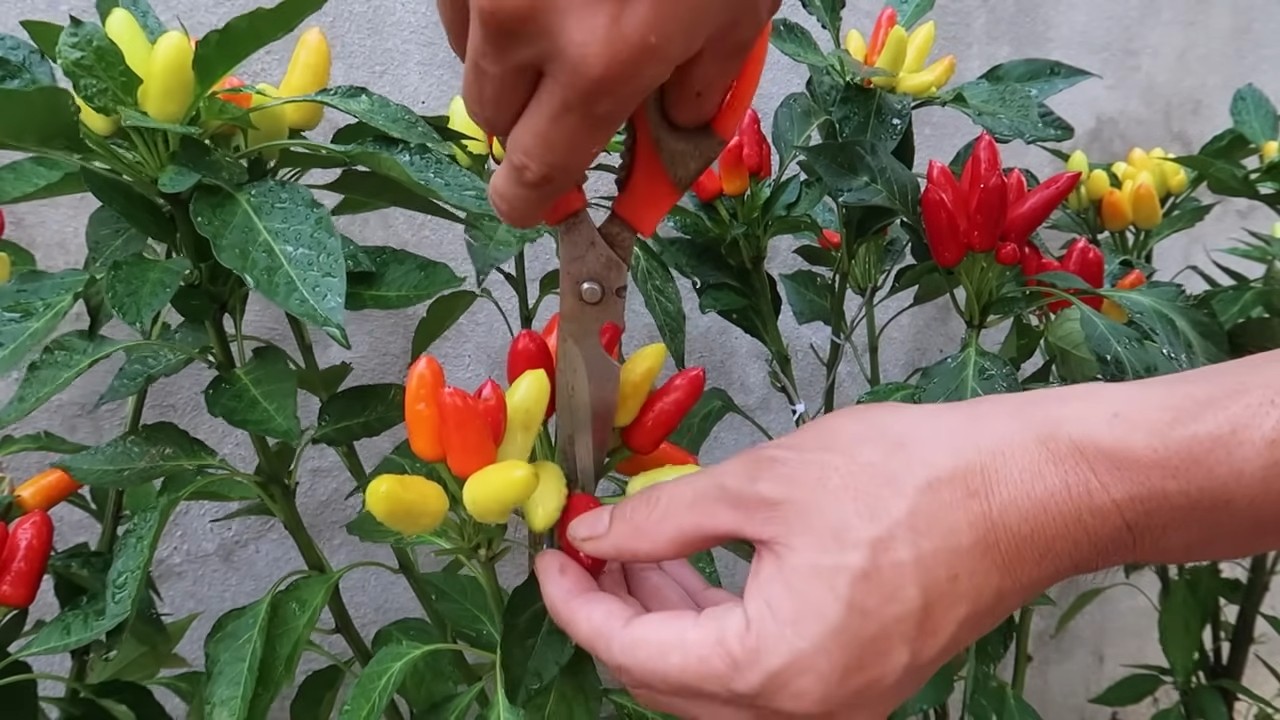
Growing Peppers in Bottles: A Fun and Space-Saving DIY Project
Hey there, fellow gardening enthusiasts! Are you short on space but dreaming of a vibrant pepper harvest? Or maybe you just want a quirky and eye-catching way to grow your favorite spicy treats? Well, you’ve come to the right place! I’m going to walk you through how to grow peppers in bottles – it’s easier than you think, super rewarding, and a fantastic way to recycle.
What You’ll Need
Before we dive in, let’s gather our supplies. This is a pretty low-cost project, which is always a bonus!
* Plastic Bottles: The star of the show! 2-liter soda bottles, water bottles (larger ones are better), or even juice bottles will work. Just make sure they’re clean and clear-ish. I prefer the 2-liter soda bottles because they offer more room for root growth.
* Pepper Seeds or Seedlings: Choose your favorite pepper varieties! Bell peppers, jalapenos, habaneros – the possibilities are endless. If you’re starting from seeds, you’ll need a seed starting tray and potting mix. If you’re using seedlings, make sure they’re healthy and well-established.
* Potting Mix: A good quality potting mix is crucial for healthy pepper growth. Avoid using garden soil, as it can compact and doesn’t drain well in containers.
* Scissors or Utility Knife: For cutting the bottles. Be careful!
* Drill or Nail: To create drainage holes.
* Watering Can or Spray Bottle: For watering your peppers.
* Fertilizer: A balanced liquid fertilizer to feed your peppers.
* Optional:
* Gravel or small rocks for drainage.
* Twine or wire for hanging the bottles (if you want to hang them).
* Paint or markers to decorate your bottles (make them pretty!).
Preparing the Bottles
This is where we transform those empty bottles into mini pepper paradises!
1. Clean the Bottles: Wash the bottles thoroughly with soap and water to remove any residue. Rinse them well and let them dry completely. This is important to prevent any mold or bacteria growth.
2. Cut the Bottles: There are a couple of ways to cut the bottles, depending on how you want to use them.
* Method 1: Hanging Planter: Cut the bottle in half horizontally. You’ll be using the bottom half as the planter. The top half can be discarded or used as a mini-greenhouse cover when the seedling is small.
* Method 2: Standing Planter: Cut off the top of the bottle, leaving a few inches of the neck. This creates a wider opening for planting.
3. Create Drainage Holes: This is essential for preventing waterlogging, which can kill your pepper plants. Use a drill or nail to create several drainage holes in the bottom of the bottle. I usually make about 5-6 holes.
4. Optional: Add Drainage Layer: Place a layer of gravel or small rocks at the bottom of the bottle to improve drainage. This isn’t strictly necessary, but it can help prevent root rot.
5. Decorate (Optional): Now’s your chance to get creative! Paint the bottles with bright colors, draw fun designs, or label them with the pepper variety. Just make sure the paint is non-toxic and won’t leach harmful chemicals into the soil.
Planting Your Peppers
Now for the fun part – getting those peppers planted!
1. Fill the Bottle with Potting Mix: Fill the bottle with potting mix, leaving about an inch of space at the top. Gently tap the bottle to settle the soil.
2. Plant Seeds (if starting from seed): If you’re starting from seed, sow a few seeds in the center of the bottle, following the instructions on the seed packet. Cover the seeds with a thin layer of potting mix and gently water.
3. Plant Seedlings (if using seedlings): If you’re using seedlings, gently remove them from their containers. Loosen the roots slightly and place the seedling in the center of the bottle. Fill in around the seedling with potting mix, making sure the top of the root ball is level with the soil surface. Gently water.
4. Water Thoroughly: Water the soil thoroughly until water drains out of the drainage holes. This helps settle the soil and ensures the roots are well-hydrated.
Caring for Your Pepper Plants
Now that your peppers are planted, it’s time to give them the TLC they need to thrive!
1. Sunlight: Peppers need at least 6-8 hours of sunlight per day. Place your bottles in a sunny location, such as a windowsill, balcony, or patio. If you don’t have enough natural sunlight, you can supplement with a grow light.
2. Watering: Water your peppers regularly, especially during hot weather. Check the soil moisture by sticking your finger into the soil. If the top inch of soil is dry, it’s time to water. Avoid overwatering, as this can lead to root rot.
3. Fertilizing: Peppers are heavy feeders and need regular fertilization to produce a good harvest. Use a balanced liquid fertilizer, following the instructions on the label. I usually fertilize every 2-3 weeks.
4. Support: As your pepper plants grow, they may need support to prevent them from falling over. You can use stakes, trellises, or even just lean them against a wall.
5. Pest Control: Keep an eye out for pests, such as aphids, spider mites, and whiteflies. If you spot any pests, treat them with an insecticidal soap or neem oil.
6. Pruning: Pruning can help improve air circulation and encourage bushier growth. Remove any yellowing or dead leaves. You can also pinch off the growing tips to encourage branching.
Harvesting Your Peppers
The moment we’ve all been waiting for – harvesting your delicious peppers!
1. Harvest Time: Peppers are usually ready to harvest when they reach their mature size and color. The exact timing will depend on the variety of pepper you’re growing.
2. Harvesting Technique: Use scissors or pruning shears to cut the peppers from the plant. Be careful not to damage the plant.
3. Enjoy Your Harvest: Now it’s time to enjoy the fruits (or peppers!) of your labor! Use your peppers in your favorite recipes, share them with friends and family, or preserve them for later.
Troubleshooting
Even with the best care, you might encounter some problems along the way. Here are a few common issues and how to address them:
* Yellowing Leaves: This can be caused by overwatering, underwatering, nutrient deficiencies, or pests. Check the soil moisture, fertilize your plants, and inspect them for pests.
* Blossom End Rot: This is a common problem in peppers, caused by a calcium deficiency. Make sure your soil is well-drained and add calcium to the soil. You can also use a calcium-rich fertilizer.
* Lack of Fruit: This can be caused by insufficient sunlight, poor pollination, or nutrient deficiencies. Make sure your plants are getting enough sunlight, hand-pollinate the flowers, and fertilize your plants.
Hanging Your Pepper Bottles (Optional)
If you want to create a hanging pepper garden, here’s how:
1. Drill Holes for Hanging: After cutting the bottle in half (using Method 1), drill two holes on opposite sides of the bottle, near the top edge.
2. Thread Twine or Wire: Thread twine or wire through the holes, creating a loop for hanging. Make sure the loop is strong enough to support the weight of the bottle and soil.
3. Hang Your Bottles: Hang your bottles from a sturdy hook, railing, or tree branch. Make sure the location gets plenty of sunlight.
Tips for Success
Here are a few extra tips to help you succeed with your bottle pepper garden:
* Choose the Right Bottle Size: Larger bottles are better for larger pepper varieties, as they provide more room for root growth.
* Use High-Quality Potting Mix: Don’t skimp on the potting mix! A good quality potting mix will provide the nutrients and drainage your peppers need to thrive.
* Water Regularly: Peppers need consistent moisture, especially during hot weather.
* Fertilize Regularly: Peppers are heavy feeders and need regular fertilization to produce a good harvest.
* Protect from Frost: Peppers are sensitive to frost. If you live in an area with cold winters, bring your bottles indoors or protect them with frost blankets.
* Have Fun! Gardening should be enjoyable. Experiment with different pepper varieties, decorate your bottles, and enjoy the process of growing your own food.
I hope this guide has inspired you to try growing peppers in bottles! It’s
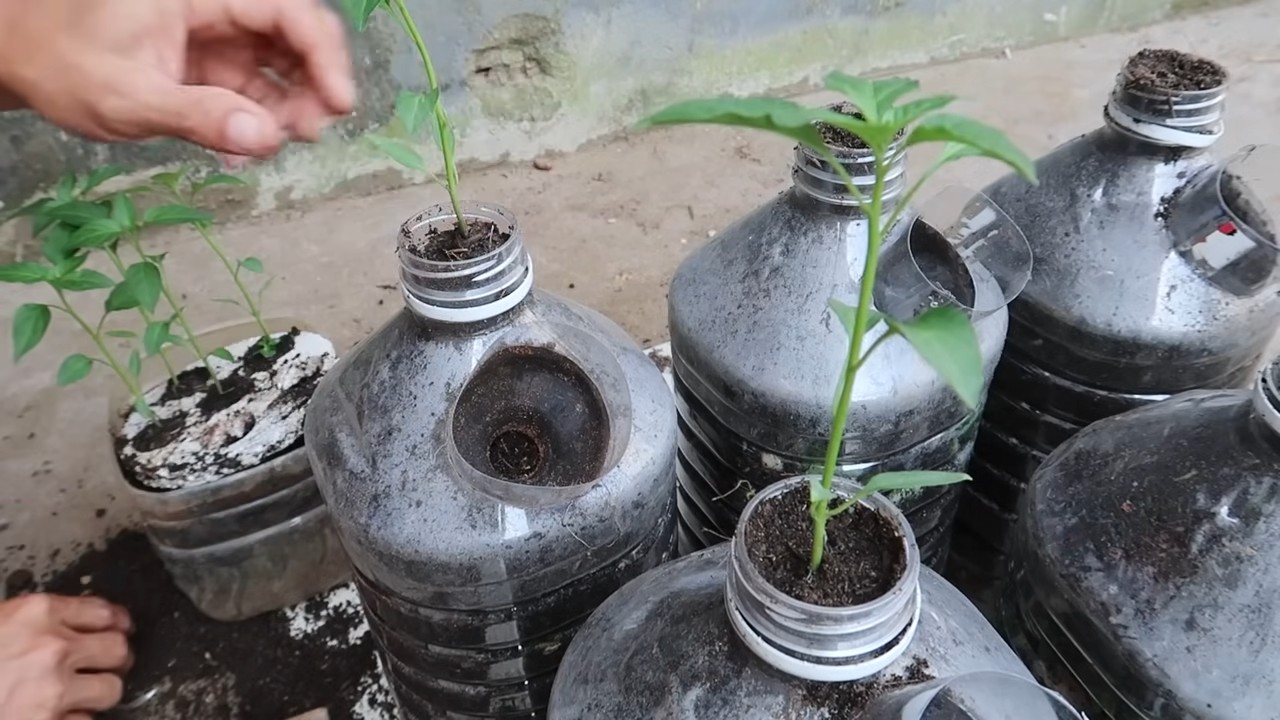
Conclusion
So, there you have it! Growing peppers in bottles isn’t just a quirky gardening experiment; it’s a genuinely effective and rewarding way to cultivate these vibrant vegetables, especially if you’re short on space or looking for a fun, eco-conscious project. We’ve explored how this method maximizes sunlight exposure, improves drainage, and offers a surprising level of control over the growing environment. Forget those sprawling gardens that demand constant weeding and watering; bottle gardening brings pepper cultivation to your balcony, patio, or even a sunny windowsill.
The beauty of this DIY trick lies in its simplicity and adaptability. You can tailor the bottle size to the pepper variety you’re growing – smaller bottles for compact chili peppers, larger ones for bell peppers or jalapeños. Experiment with different bottle colors too! While clear bottles are the most common, darker bottles can help retain heat in cooler climates, giving your peppers an extra boost. Consider painting the bottles white to reflect excess heat in hotter regions.
Beyond the practical benefits, growing peppers in bottles is an incredibly satisfying experience. Watching those tiny seedlings sprout and flourish within their recycled containers is a testament to the power of sustainable gardening. It’s a fantastic way to reduce waste, connect with nature, and enjoy the freshest, most flavorful peppers imaginable.
But don’t just take our word for it! We wholeheartedly encourage you to try this DIY trick for yourself. Gather your bottles, prepare your soil, and get ready to embark on a pepper-growing adventure. Whether you’re a seasoned gardener or a complete beginner, you’ll be amazed at how easy and rewarding it is to grow your own peppers in bottles.
And once you’ve harvested your bounty, we’d love to hear about your experience! Share your photos, tips, and stories in the comments below. Let’s create a community of bottle-gardening enthusiasts and inspire others to embrace this innovative and sustainable approach to growing delicious peppers. Let us know what varieties you tried, what challenges you faced, and what successes you celebrated. Your insights will be invaluable to fellow gardeners who are just starting out. Happy growing!
Frequently Asked Questions (FAQ)
What type of bottles are best for growing peppers?
The best bottles for growing peppers are typically clear plastic bottles, such as those used for water, soda, or juice. Clear bottles allow maximum sunlight to reach the plant. However, you can also use colored bottles, keeping in mind that darker colors will absorb more heat, which can be beneficial in cooler climates but potentially harmful in hotter ones. Ensure the bottles are thoroughly cleaned before use to remove any residue that could harm the plants. Avoid bottles that have contained harmful chemicals. The size of the bottle should be appropriate for the pepper variety you intend to grow; larger peppers will require larger bottles.
How do I prepare the bottles for planting?
Preparing the bottles is a crucial step. First, thoroughly clean the bottles with soap and water to remove any residue. Then, create drainage holes in the bottom of the bottle. These holes are essential to prevent waterlogging, which can lead to root rot. You can use a drill, a hot nail, or a sharp knife to create these holes. Be careful when using sharp tools. Next, cut the top portion of the bottle off to create an opening for planting. You can either remove the top completely or invert it to create a makeshift funnel for watering. Finally, consider adding a layer of gravel or small stones to the bottom of the bottle to further improve drainage.
What type of soil should I use for growing peppers in bottles?
The ideal soil for growing peppers in bottles is a well-draining potting mix. Avoid using garden soil, as it can be too heavy and compact, hindering root growth. A good potting mix will retain moisture while allowing excess water to drain away. You can also amend the potting mix with compost or other organic matter to provide additional nutrients. Consider adding perlite or vermiculite to improve drainage and aeration. A slightly acidic to neutral pH is ideal for peppers.
How often should I water my pepper plants in bottles?
The frequency of watering depends on several factors, including the weather, the size of the bottle, and the type of potting mix you’re using. Generally, you should water your pepper plants when the top inch of soil feels dry to the touch. Avoid overwatering, as this can lead to root rot. When watering, water thoroughly until water drains out of the drainage holes. During hot weather, you may need to water more frequently. Check the soil moisture regularly to ensure your plants are getting the right amount of water.
How much sunlight do pepper plants need when grown in bottles?
Pepper plants need at least 6-8 hours of direct sunlight per day to thrive. Place your bottles in a sunny location, such as a south-facing balcony or patio. If you don’t have access to enough natural sunlight, you can supplement with grow lights. Rotate the bottles regularly to ensure that all sides of the plant receive adequate sunlight. Insufficient sunlight can lead to leggy growth and reduced fruit production.
What kind of fertilizer should I use for pepper plants in bottles?
Pepper plants are heavy feeders and benefit from regular fertilization. Use a balanced fertilizer with an NPK ratio (nitrogen, phosphorus, potassium) of 10-10-10 or 14-14-14. You can also use a fertilizer specifically formulated for vegetables. Apply the fertilizer according to the package instructions. Avoid over-fertilizing, as this can burn the roots. You can also supplement with organic fertilizers, such as compost tea or fish emulsion. Fertilize regularly throughout the growing season to ensure your plants have the nutrients they need to produce abundant peppers.
How do I protect my pepper plants from pests and diseases when growing in bottles?
Growing peppers in bottles can actually help reduce pest and disease problems, as the elevated position can make it harder for pests to reach the plants. However, it’s still important to monitor your plants regularly for signs of pests or diseases. Common pests that affect pepper plants include aphids, spider mites, and whiteflies. You can control these pests with insecticidal soap or neem oil. Diseases such as powdery mildew and blossom end rot can also affect pepper plants. Ensure good air circulation to prevent fungal diseases. Blossom end rot is often caused by calcium deficiency, so you can amend the soil with calcium or use a calcium-rich fertilizer.
Can I grow different varieties of peppers in bottles?
Yes, you can grow different varieties of peppers in bottles. However, it’s important to choose varieties that are well-suited to container gardening. Compact or dwarf varieties are often a good choice. Be sure to provide each plant with enough space to grow. You can also grow multiple pepper plants in a single large bottle, but be sure to space them adequately to prevent overcrowding. Experiment with different varieties to find your favorites.
How do I harvest my peppers when growing in bottles?
Harvesting peppers is a rewarding part of the growing process. The timing of the harvest depends on the variety of pepper and your personal preference. Generally, peppers are ready to harvest when they have reached their mature size and color. Use a sharp knife or scissors to cut the peppers from the plant, leaving a small stem attached. Handle the peppers carefully to avoid bruising. Enjoy your homegrown peppers fresh, or preserve them by pickling, drying, or freezing.
What do I do with the bottles after the growing season is over?
After the growing season is over, you can reuse the bottles for future plantings. Clean them thoroughly and store them in a dry place. You can also recycle the bottles if you no longer need them. Consider donating them to local schools or community gardens. By reusing or recycling the bottles, you can further reduce your environmental impact and promote sustainable gardening practices.

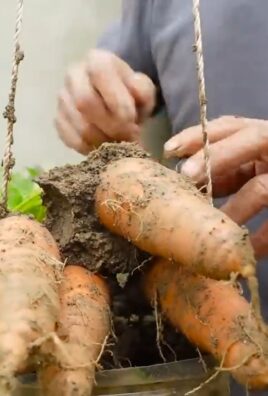
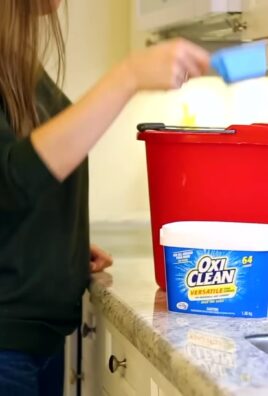
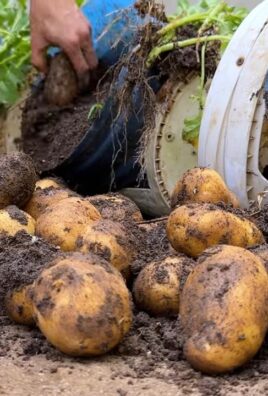
Leave a Comment